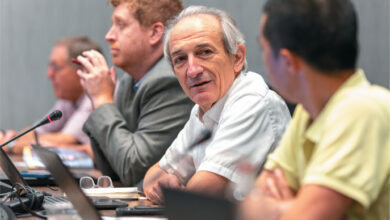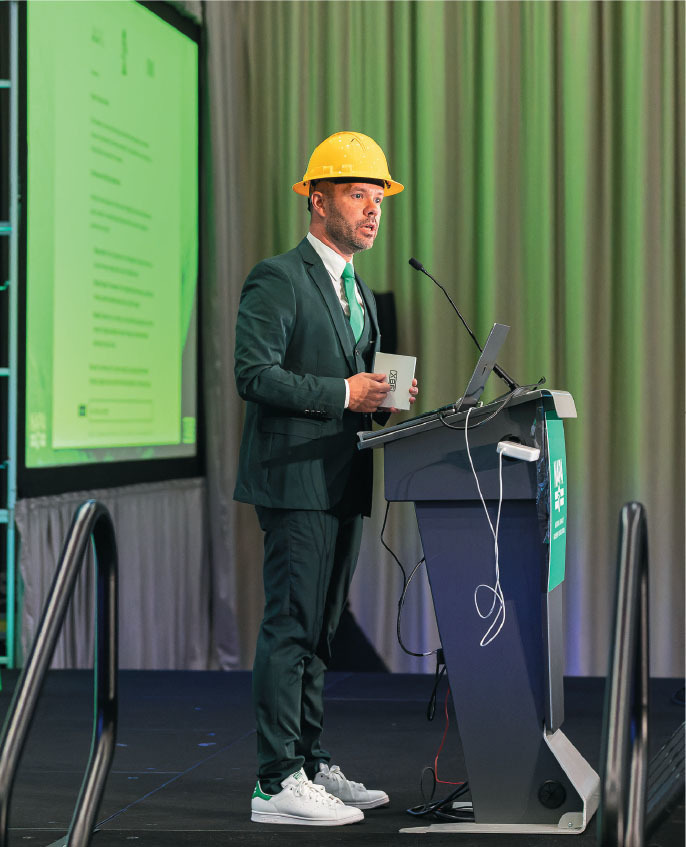TCC Fly-in Key to Year-Round Advocacy

Meeting in person, building relationships help stave off disruptive policies while making the case for funding.
BY TY JOHNSON, MANAGING EDITOR
When the 118th Congress began in January, it welcomed seven new senators and 74 new voting members of the U.S. House of Representatives, including its youngest lawmaker in Florida Congressman Maxwell Frost, who was born in 1997.
Reaching this new generation of lawmakers who may have read about landmark highway bills like the Intermodal Surface Transportation Efficiency Act (ISTEA) in history books has placed a premium on shoe-leather advocacy on Capitol Hill, according to Nile Elam, NAPA’s Vice President for Government Affairs.
Nile began work at NAPA in February and set to work navigating the challenges of engaging with new members of congress who interact with asphalt pavements every day, but may not understand how the federal government funds it.
“We are now dealing with a Congress where a lot of members don’t understand what the FAST Act was, or SAFETEA-LU,” Elam said, using the acronyms for the 2015 Fixing America’s Surface Transportation Act and the 2005 Safe, Accountable, Flexible, Efficient Transportation Equity Act: A Legacy for Users, respectively. “They may not have an appreciation for state obligations, and working between state DOTs and the U.S. DOT, and the funding exercises that need to be fulfilled, not only through the authorizing committees, but through the appropriations committees. They need to be keenly aware that Congress has a duty to ensure we have an interstate and national highway system, that it’s well maintained, and that we have interstate commerce.”
Elam explains that while he came aboard at NAPA to help make connections between the industry and the Capitol, he mostly wants to serve as a conduit to help asphalt pavement producers reach the ears of the decision makers.
“Members of Congress and their staff, they take the word of the people who do the work,” he said. “And at the end of the day, if they can talk to that owner or employee of an asphalt plant in their district, who also happens to be their voter, that will 10 out of 10 times outweigh anything I can ever hope to do on my own.”
And while Nile said popping in on your representatives when you are in Washington, D.C., for business or as a field trip chaperone is welcome, more formal industry actions, like the Transportation Construction Coalition Fly-In, present opportunities for NAPA members to speak directly with the power players within agencies, committee staffs, and congressional member offices that impact roadbuilding policies the most.
COALITION CHORUS
Just as NAPA unites asphalt producers, contractors, and supporters of the industry into a single voice, so does the TCC bring together 33 organizations, from trade associations to union organizations, to engage with lawmakers about the need to invest in transit infrastructure.
Partnering with coalition members like the National Stone, Sand & Gravel Association has proven fruitful, Nile said, and he speaks from experience since he previously worked for NSSGA.
“We don’t always agree 100 percent of the time – close to it – but we agree on a lot of the big policies; and, if we can work together, we can achieve great things. That’s something we saw in IIJA,” he said, using the acronym for the 2021 Infrastructure Investment and Jobs Act, the largest surface transportation bill in history.
Elam said while he was at NSSGA and partnering with NAPA to bring advocacy messaging to shared members between aggregate and asphalt, the similarities between the two organizations outshone the differences.
“We wanted a robust highway surface transportation bill, we wanted the Highway Trust Fund to be solvent, we wanted to ensure that there weren’t harmful environmental regulations that had unintended consequences on how you permit an aggregate facility or an asphalt plant,” he recalls. “The rocks that we were providing in the construction materials space was a dependent input for asphalt producers. If those members weren’t already overlapped, obviously a lot of their infrastructure priorities were aligned.”
NSSGA Vice President of Government and Regulatory Affairs Michele Stanley said that teamwork is still prevalent within the coalition, not only in organizing the annual Fly-In, but in reaching lawmakers when it matters most.
“As long as we’re all saying the same thing, and saying it from different directions, it helps to push the point across to the members,” she said, noting that the associations in the highway materials space worked together to ensure IIJA’s Buy America provisions were not disruptive to industry. “We were making sure our collective voice was heard and it never would have gotten as far as it did if we were doing it separately.”
As for reaching the new crop of aides and legislators on Capitol Hill, Stanley said one overlooked approach is for members to meet them at the plant or job site.
“Members of Congress love to put on hard hats and get on top of big equipment,” she said, noting that quarry tours and asphalt plant visits within their districts make for great networking opportunities, and can set members up for more productive visits in Washington. “If they’re at your facility, one of the best talking points is to share what your businesses do on a daily basis. There’s a senator who still talks to me about the time when she visited an asphalt facility and got to dump a load of asphalt. She thought it was the greatest thing ever.”
Attending state or regional days at the Capitol can help supplement conversations begun at the Fly-In, too, she said, while noting that only 30 percent of those sitting in Congress have been through a previous reauthorization.
“That’s a pretty drastic number of folks you have to educate on the process,” she said.
Michele said one note she highlights in her discussions on the Hill is how important these multi-year bills are for business owners in roadbuilding, aggregates, and related industries.
“(IIJA) was so important because of the certainty it provided for their businesses,” she said, noting that the conversations along the way helped the bill writers navigate issues like permitting, sustainability, and Buy Clean efforts. “They don’t know what our members do every day at their operations and don’t understand what sustainability means to an aggregate or asphalt facility or road project,” she said. “It’s one thing for members (of Congress) to read about it in a magazine article, but it’s different for people to be in front of them telling them about an experience they had.”
Stanley said the certainty of five years’ worth of highway funding also empowers states to match federal funding with their own initiatives, from growing gas tax revenue in Mississippi to electric vehicle fees in Louisiana. She said both Rep. Sam Graves (R-Missouri), who chairs the Transportation and Infrastructure Committee, and T&I Ranking Member Rep. Rick Larsen (D-Washington) embraced common sense approaches to funding the Federal Highway Trust Fund.
“They were both saying the same thing: ‘Everyone needs to pay into the system in order for the system to work.’”
SHOW AND TELL
Stanley said the biggest challenge for TCC members going forward will be making the Highway Trust Fund solvent while keeping the drumbeat for a new highway bill when IIJA sunsets Sept. 30, 2026.
“Nobody else is even thinking that far ahead, but If we’re not talking about it and working with other folks to find a way forward it’s not going to happen and we’re only going to hurt ourselves further down the line,” she said, noting that language markup on the bill could start as early as the second half of 2024.
Solving a decades-long issue like keeping the Highway Trust Fund solvent is a monumental task, but Stanley said that’s where large coalitions like the TCC can shine, especially when members speak firsthand about how decisions in the halls of Washington can affect the lives of their workers at plants and job sites.
“If we’re not the ones investing time and energy into figuring that out, no one will,” she said, noting that historically Congress has waited to solve issues until the eleventh hour.
Stanley said getting in the same room with lawmakers and staff can mean more success down the road.
“Nothing beats coming to D.C. and meeting in person,” she said. “Helping build those relationships with members of Congress is the best way to just have a normal conversation, not like a virtual meeting where you have the meeting and leave. The conversation you have with the staffer in the front office or the two seconds when you realize your kids go to the same school, or you attend the same church – those don’t naturally happen over a virtual meeting. That’s the biggest plus about having in-person meetings.”
Elam concurred: “Even if you can’t be a part of the Fly-In, continue to work with your members of Congress by reaching out to your district staff, and work with NAPA to help create those connections if you don’t already have them to ensure that we’re a constant voice. We want to make sure that these conversations continue to happen,” he said. “Congress does a phenomenal job of procrastinating and as a result, things that move at a glacial pace can suddenly move at meteoric pace. Ensuring that they know that we’re here to help is critical. They don’t have the tools to assume to know everything happening in the asphalt industry. Without us, their best tool is Google, and you can imagine how narratives can be misinterpreted if we aren’t raising our own voices.”
Still, Elam said the best way for members to start those conversations is by dusting off their business cards and putting a face to a name with a handshake.
“Virtual meetings and calls are a little bit more normalized, but on Capitol Hill, it’s still an in-person business,” he said. “The Hill is reopened, and offices are eager to have visitors and constituents come in and it’s best to take advantage of that because these are committee and member officers that are largely staffed by folks between the ages of 22 and 32. They are learning a lot of these industries and hosting these meetings for the first time – our presence makes a positive difference.”
Elam said while the asphalt pavement industry has a story to share with lawmakers, getting it to stick in a significant way is the true challenge.
“Now it’s just ensuring that this crop of newly elected officials, from coast-to-coast and border-to-border, understand that the asphalt pavement industry is a significant one and is largely responsible for the most touched product that they experience day in and day out – the road that they drive on.”
MEET NSSGA CHAIR SETH HANKOWSKI
In March, the National Stone, Sand & Gravel Association (NSSGA) welcomed its 2023 Chair Seth Hankowski, who is Senior Vice President at NAPA member All States Materials Group in Massachusetts. “It really is a big assist to a small producer like us to have an association at the federal level keeping an eye on what’s not just going on in our backyard, but what’s going on in the entire country,” Hankowski said in a welcome video. To learn more about Hankowski, and his journey to leadership within NSSGA, scan the QR code.




